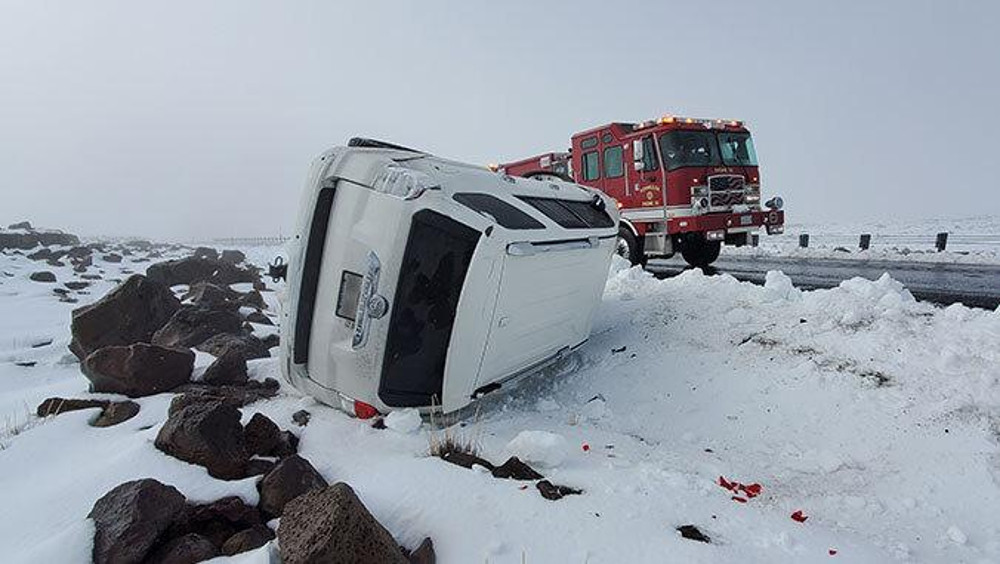(BIVN) – With more snow in the forecast for the higher elevations of Maunakea, the University of Hawaiʻi is urging residents to exercise caution should they travel to the summit.
The University is charged with the management of the Maunakea summit under its lease agreement with the Hawaiʻi Department of Land and Natural Resources.
23-year-old Pua Wong was seriously injured on the summit of Maunakea last Friday evening, after she ran into some rocks while body boarding in the snow. A GoFundMe account has been set up to help the family with medical expenses.
From the University:
Hawaiʻi Island residents are urged to exercise caution when traveling and visiting the summit of Maunakea. Four people required medical attention this past weekend while in the summit areas—two individuals were injured, one seriously, while playing in the snow in separate incidents, and two individual suffered from altitude sickness, according to the Maunakea Rangers from the University of Hawaiʻi at Hilo Center for Maunakea Stewardship. Two car accidents were also reported, including an overturned vehicle, as there is normally an increase in summit traffic after a heavy snowfall.
The public is asked to remember that the summit of Maunakea can be one of the most dangerous places in Hawaiʻi because of the extreme altitude and weather conditions, and emergency services may be two hours away because of its remote location. Cell phone coverage is unreliable, and there is one public emergency phone on the summit.
Be safe and respectful
Everyone is encouraged to act in a safe and responsible manner while on Maunakea and look out and care for others because of the dangerous conditions. Please be respectful of the fact that Maunakea is one the most revered places in Hawaiʻi, and many visit the mauna for cultural and religious practices. For everyoneʻs safety, please heed all directions and precautions from Maunakea Rangers.
Drivers seeking to reach the summit area are asked to remember the following:
- Only 4-wheel drive vehicles are allowed beyond the Visitor Station.
- Vehicles should be in good working condition, especially the brakes, contain sufficient fuel and be free of invasive species, which can be an issue with dirty and muddy vehicles
- Adhere to the 25 mile-per-hour speed limit and be aware of other vehicles and pedestrians on the road.
- While going down the mountain, use a low gear to prevent brake failure and do not ride your brakes.
- If you experience brake loss, turn into the mountainside to avoid rolling down.
- Road conditions become more hazardous when there are deep snow drifts.
- Before leaving, check the weather and summit road conditions at the Maunakea Weather Center website.
- Do not litter or disturb terrain or rock piles
- Use the portable toilets at the Visitor Station and on the summit. Do not go to the bathroom outdoors.
- Pets are not allowed on UH managed lands on Maunakea, including the summit, Maunakea Summit Road and the Visitor Station.
Snow, sun and weather
Snow on the summit will typically have a thick layer of ice on top that makes it very hard to steer or stop. The slopes are very steep with rocky outcroppings at the bottom, which is where most serious injuries occur. It is strongly advised NOT TO USE inner tubes, boogie boards or other devices that are NOT equipped with braking or steering mechanisms.
Wear sunscreen and sunglasses because of the high risk of sunburn and eye damage, as the summit is above much of the atmosphere that blocks the sun’s damaging ultraviolet rays. The threat increases if there is snow on the ground.
The weather can change rapidly, resulting in severe conditions including freezing temperatures, snow storms and high winds. Dress and prepare appropriately.
Exposure to Altitude
The summit elevation is 13,796 feet (4,205m), and there is 40% less oxygen available there compared to sea level. With the greatly reduced oxygen level, visitors can experience altitude sickness that could include shortness of breath, impaired judgment, vomiting and a loss of consciousness. In extreme cases it could lead to life-threatening conditions.
All travelers to the summit are asked to acclimate to the high elevation by spending at least a half hour at the Visitor Information Station located at the 9,200 ft (2,804 m) elevation, which can lessen the intensity or onset of altitude sickness.
The University also says that visitors should “keep hydrated to help you avoid elevation sickness and NOT drink alcoholic beverages before or while on the Maunakea summit road.”
Also, UH says do not travel above the Visitor Information Station if you:
- Are pregnant
- Are in poor physical condition, especially if you have heart and respiratory problems
- Are a child under the age of 13
- Have gone scuba diving within 24 hours
“When on the summit, move slowly and deliberately and always remember you are already physiologically impaired due to the reduced atmosphere,” UH officials say.


by Big Island Video News11:33 pm
on at
STORY SUMMARY
MAUNAKEA, Hawaiʻi - The University of Hawaiʻi says four people required medical attention this past weekend while in the summit areas.